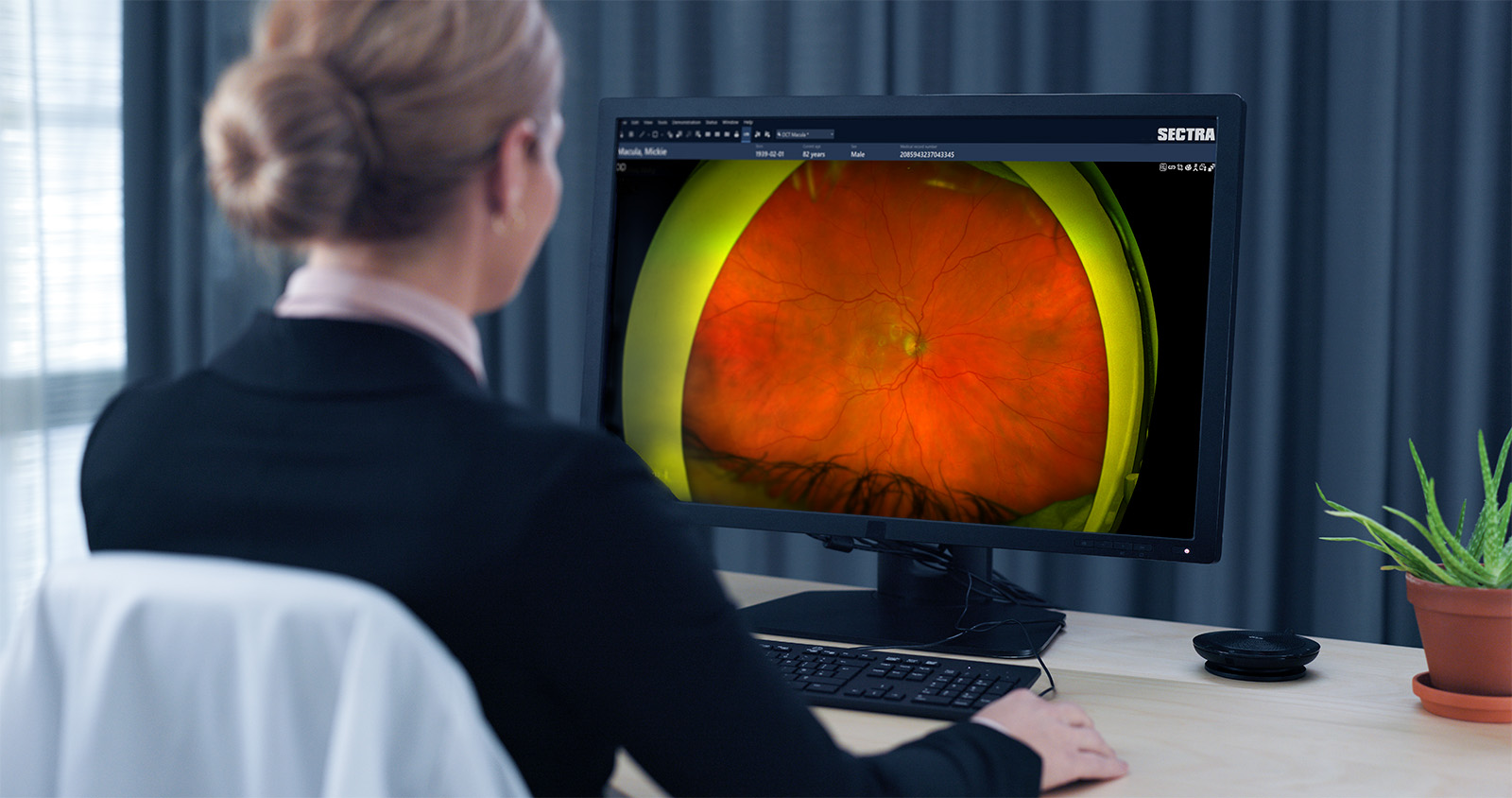The treatment of eye diseases depends heavily on medical imaging, and there are many opportunities for ophthalmology to innovate in this area. Rivierenland Hospital in Tiel is a great example of such an innovation. The hospital is leading the way in the Netherlands, becoming the first to start working with the latest addition to Sectra’s enterprise imaging portfolio—Sectra Ophthalmology Imaging. Shortly before the system went live, Sectra spoke to Kenneth Rouwen, the ophthalmologist involved, and Leanne Grimm, unit manager at the ophthalmology outpatient clinic. Here, they discuss the initial process and share their vision of innovation in ophthalmology imaging.
Innovating at Rivierenland Hospital
The demand for image storage has grown significantly in recent years. Rouwen emphasizes the rising number of patients and the growing demand for additional examinations, underscoring the growing importance of proper image storage. Examinations such as visual field studies, fluorescence angiography (FAG) and optical coherence tomography (OCT) also generate large amounts of images.
Rivierenland Hospital was looking for new software for its ophthalmology department that offered more functionality and supported the department’s growing need for image storage. Since Sectra PACS was already being used at the radiology department, it made sense to take a closer look at the ophthalmology solution. Implementing a hospital-wide image management system can improve departmental efficiency, particularly when considering collaboration with other image-rich disciplines, such as radiology and pathology.
Rivierenland Hospital was the first hospital in the Netherlands to work with Sectra’s ophthalmology solution. The hospital’s old solution merely displayed images for manual examination. “You could only juxtapose images, but weren’t able to automate anything, because there were no metadata. Now we have the metadata, so that is a major advantage,” Rouwen says.
Enterprise imaging: from radiology to ophthalmology
The ophthalmology department chose to start with Sectra Uniview, a viewer for medical images that can be linked to the hospital’s electronic health record (EHR). During the project, the team decided to switch to the IDS7 viewer to add even more capabilities. As the project evolved, the ophthalmology module was added for additional functionality, including fundus mounting and specific measurements.
Having Sectra PACS in-house meant we had a wealth of existing knowledge, and our own staff could oversee the project. This enabled the radiology implementation coordinator to ask exactly the right questions for the ophthalmology department.
Rouwen stresses the benefits of uniformity in the use of Sectra PACS and the ability to exchange images with other hospitals. This saved time and prevented the ophthalmology department from having to reinvent the wheel with a separate imaging system. Trust in the Sectra system also influenced the department’s decision, according to Grimm: “Having Sectra PACS in-house meant we had a wealth of existing knowledge, and our own staff could oversee the project. This enabled the radiology implementation coordinator to ask exactly the right questions for the ophthalmology department.”
Using existing knowledge and experience
The initial process commenced in January/February 2023 and progressed smoothly. The lead-up to the go-live consisted of two phases. “First,” says Rouwen, “migrating the old data and second, connecting the modalities to Sectra PACS.” Some elements could not be transferred directly during the migration. “This was to be expected and required some manual work behind the scenes. But I can say that the overall process went very well,” Grimm adds.
During this process, the project group spoke to Sectra on a weekly basis, while the functional management team consulted Sectra on a bi-weekly basis. “They really guided us through it, using their experience from similar projects, which gave us a lot of support as a sounding board,” Grimm says. Rouwen adds that he was able to discuss more specialty-specific needs in the ophthalmology solution as well. Consequently, these additions are now being implemented as updates.
The biggest gain is in the link with the EHR. Whoever opens the examination in the EHR will see the images in Sectra PACS immediately.
To ensure quality in the future, “we set up an additional admin team,” says Grimm. “A number of employees in the ophthalmology department are now also trained to manage this part of the PACS. That way, if something is not working optimally, it can be reported back quickly.”
For the first time, the ophthalmology department now also works with a closed-loop data exchange, resulting in an extra layer of security and efficiency. Rouwen explains: “The biggest gain is in the link with the EHR. Whoever opens the examination in the EHR will see the images in Sectra PACS immediately.” An additional advantage, according to Grimm, is that the patient data is automatically available on the modality worklist.
“Before, the patient data had to be entered manually, which takes time and, more importantly, is much more susceptible to error. With this system, you no longer have that risk.
A multifaceted collaboration
In addition to strengthening the existing collaboration around the PACS, Grimm notes that many people and departments within the hospital are involved in this type of innovation: “Ophthalmologists, the IT department, the purchasing department, the medical instrument service, unit managers, care managers, department coordinators, system architects, test managers and project managers. And it is important to involve these people from the start. In addition, weekly meetings and short communication lines with Sectra brought further efficiency gains.”
Rouwen also remarks, “Because everyone approaches the project from their unique perspective, we’ve designed the system to ensure it functions effectively for all. I firmly believe that collaborating and addressing any issues before they arise is preferable to having to resolve them later.”
Featured products & services
Related cases



